July 7, 2022
Palm oil nosedives to a 25-week low and shipping reliability remains between 30 and 40 percent
1 RM (Malaysian Ringgit) = 0.23 USD
1 USD = 0.82 GBP
Crude Palm Oil
Average April Palm Oil Export Prices
-
Indonesia
$1,771/tonne (-$24/tonne) -
Malaysia
$1,722/tonne (-$32/tonne)
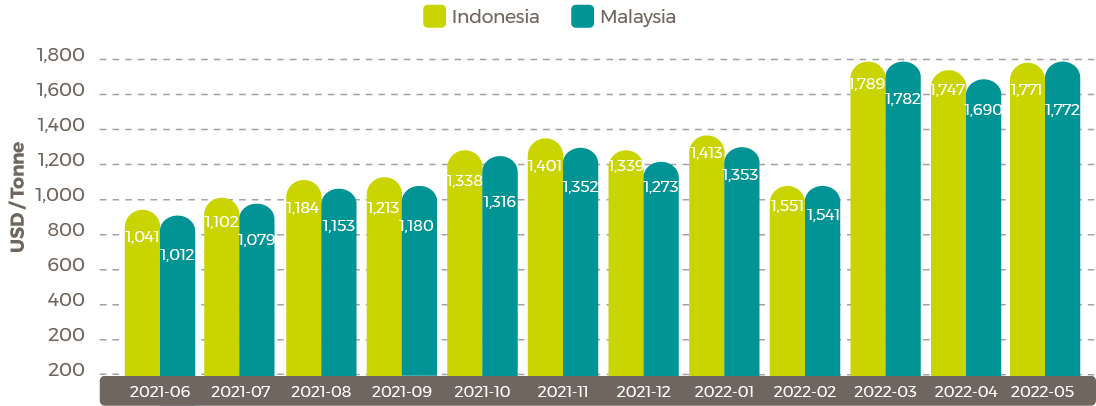
Source: USDA Foreign Agricultural Service
Malaysia palm market
As reported in the June 10 Palm Update, Crude Palm Oil (CPO) prices had a volatile start to June as the market reacted to Indonesia lifting its palm export ban on May 23. Despite opening up supply, the market remained strong in the first week of June with reported increased demand from India.
Seeing a high of 6505 RM/tonne ($1,476.06) on June 7, Malaysia’s CPO settlement price started a 14-day nosedive following an announcement from the Indonesian government that the CPO export and levy rate would be lowered from $575 per tonne to $488 per tonne.
This resulted in a 25-week low of 4499 RM/tonne ($1,020.88) on June 22, with prices not near that level since the last week of December 2021.
Malaysia’s CPO settlement price began to regain some ground, getting to 4989 RM/tonne ($1,132.06) on June 28 but had started to decline again, closing the month at 4760 RM/tonne ($1,080.10).
According to the Oil Market Report from oil and fat manufacturer Olenex, the price fall was influenced by a heavy stock build-up in Indonesia due to the export ban.
“With the market inverted and the fact that combined export levy and tax in Indonesia is $488 until the end of July and $528 from the 1st of August, sellers are keen to sell/ship out as much oil as possible before the end of July,” says Olenex’s Week #25 report.
Also contributing is a slowdown of vegetable imports from China, says USDA in its latest Oilseeds report, with COVID-19 lockdowns and high vegetable prices reducing demand for palm, soy and rapeseed cooking oils.
“(Marketing Year) MY2021/22 vegetable oil imports are slashed to 2017/18 levels with palm oil imports reduced by 500,000 tons, soybean oil 350,000, and rapeseed oil 150,000 this month. Additionally, sunflowerseed oil imports are cut 500,000 tons as Russia’s invasion of Ukraine has significantly disrupted logistics and shipments of oilseeds and products to global markets. As a result, China's vegetable oil consumption is projected to decline for the first time since the early 2000s. Total food consumption is estimated at 36.1 million tons, down 3 percent from the previous marketing year,” reports USDA.
Malaysia palm prices CPO Settlement Price RM
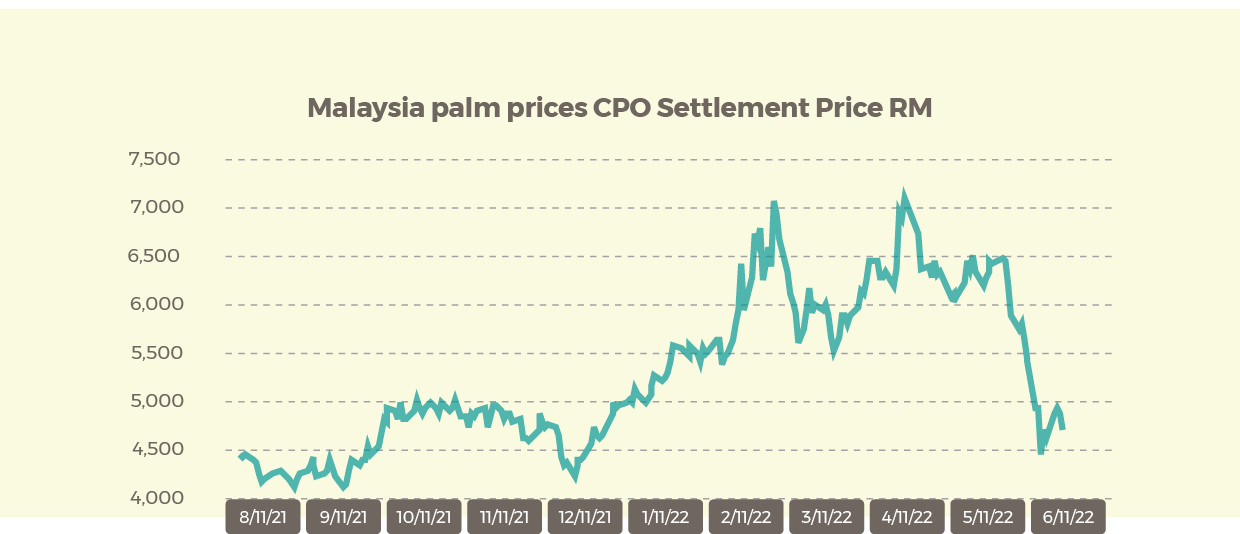
Soybean oil
May 2022 Soybean Oil Export Prices $/tonne
A strong demand versus supply balance has led to a US soybean oil premiums approaching $150/tonne. According to USDA, the US market is projected to consume 93 percent of all soybean oil produced this year. Brazil is expected to consume 80 percent of its domestic supply while Argentina is expected to only consume 13 percent. US demand is being driven by industrial uses, including biodiesel.
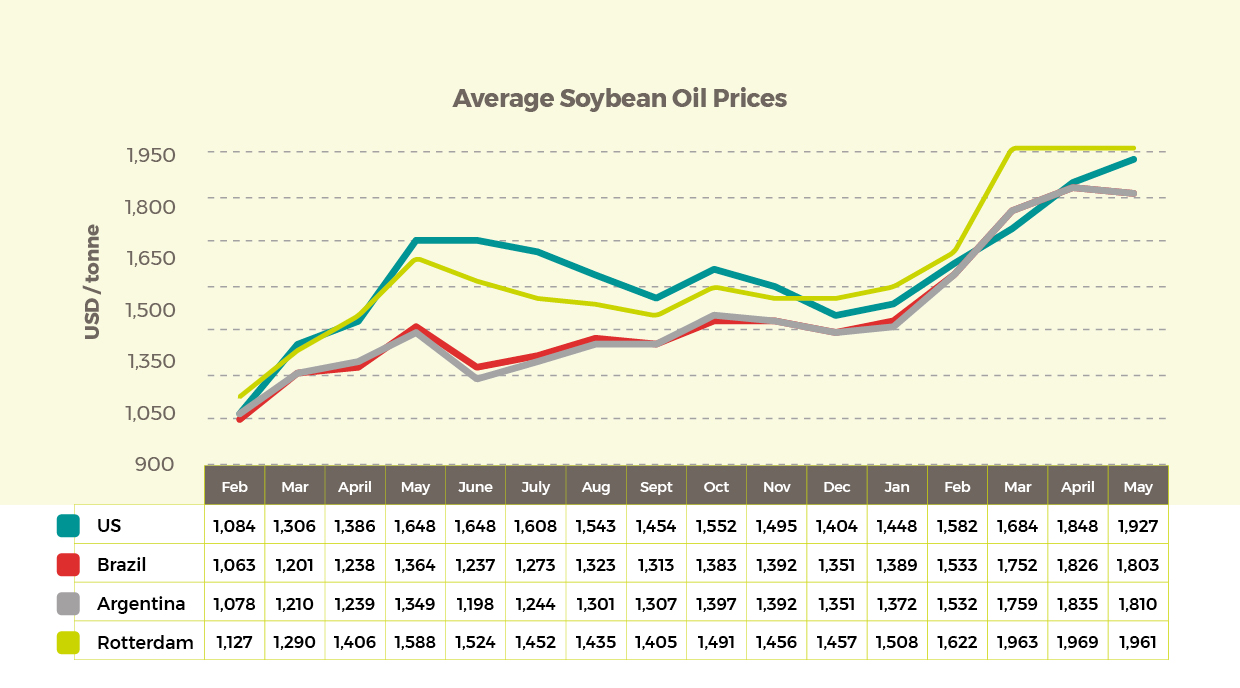 USDA’s 2022/2023 Oilseed Outlook
USDA’s 2022/2023 Oilseed Outlook
Oilseed production
- Global 2022/23 oilseed production is forecast at nearly 647 million tons
- Reduced sunflowerseed in Ukraine and rapeseed in the European Union more than offset gains for soybeans in Ukraine and Zambia and rapeseed in Australia
Oilseed exports
- Oilseed exports are raised on Australia rapeseed and Ukraine soybeans which exceed a reduction for Argentina sunflowerseed
- Global vegetable oil trade is slightly lower on reductions for Ukraine sunflowerseed oil exports which more than offset gains for Turkey sunflowerseed oil and Canada rapeseed oil exports
- Global protein meal exports are slightly lower this month following reduced sunflowerseed production in Ukraine as well as lower rapeseed meal in India
Oilseed stocks
- Global oilseed stocks are up nearly 1 million tons primarily on larger Argentina soybean stocks
- The projected U.S. season-average farm price for soybeans is up 30 cents to a record $14.70 per bushel
Rapeseed oil
Average Rapeseed Rotterdam (Canola) Oil Prices 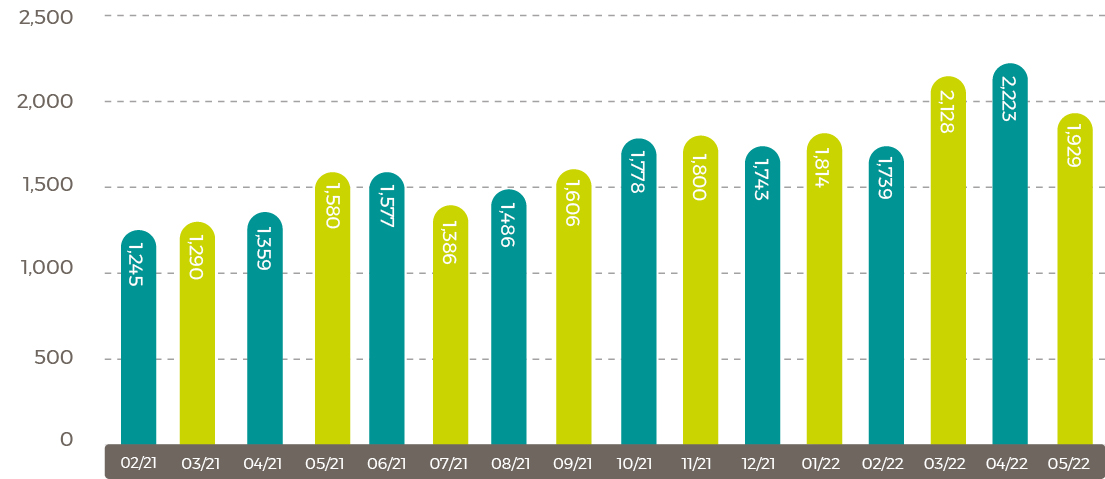
Sunflower oil
Average Sunflower Seed Oil Prices 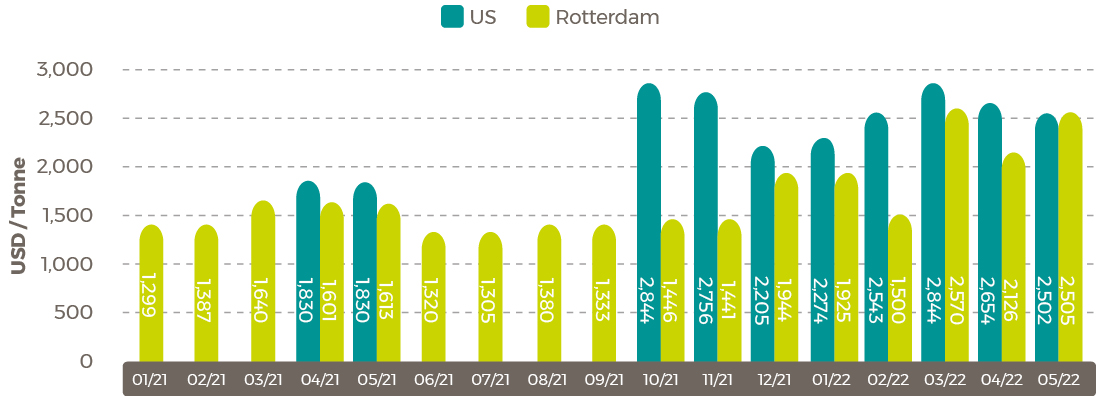
Shipping update
Schedule reliability remains between 30 percent and 40 percent
According to maritime data analysis company Sea-Intelligence, the global schedule reliability is similar to 2021, with an average of 36.4 percent in May 2022.
“Additionally, the average delay for late vessel arrivals was reduced once again, this time by 0.37 days to 6.17 days in May 2022. The delay figure is now firmly below the seven-day mark, but it is still the highest in each month when compared historically, although with the margin decreasing sharply,” reports Container News.
Maersk leads the industry in reliability, with a score of 50.3 percent, with Hamburg Süd following at 43.7 percent. According to the analysis, six carriers had a 20 to 30 percent reliability and six carriers had a 30 to 40 percent reliability. Wan Hai had the lowest score at 22.1 percent.
The full report can be read here.
Long-term shipping rates shrug off uncertainty to rise again
June container shipment rates increased by 10.1 percent in June shows data from ocean freight data analysis firm Xeneta.
“Following on the heels of a record 30.1% hike in May, this now means rates stand 169.8 percent higher than this time last year, with just two months of declines in the last 18 months. Despite a degree of macro-economic uncertainty clouding the horizon, all major trades saw prices moving up, with some corridors showing significant gains,” reports Hellenic Shipping News on the recent Xeneta Shipping Index Public Indices.
“European imports index continued their recent climb, rising 13.7 percent to stand 163.4 percent higher than the equivalent period last year. The regional export index jumped by 6.2 percent and is now 148.2 percent up year-on-year. Similar signs were seen for Far East imports and exports, with the former rising 5 percent (up 62.5 percent against June 21) and the latter jumping 11.6 percent. The export benchmark is now a mighty 200.6 percent up year-on-year. This performance was mirrored by the US import figure, which climbed 8.6 percent over the month to stand 203.2 percent against last June. Growth on exports was more modest, with a 0.3 percent rise taking the index 41.7 percent up year-on-year.”
In the meantime, Xeneta is projecting rates to continue upwards. However, its analysis argues that the “relationship between their community, shippers and, to some extent, other key society stakeholders has been damaged by disruption, poor quality services (in terms of reliability) and runaway rates increases.”
Disclaimer: The information in this document has been obtained from or based upon sources believed to be reliable and accurate at the time of writing. The document should be for information purposes only and is not guaranteed to be accurate or complete.